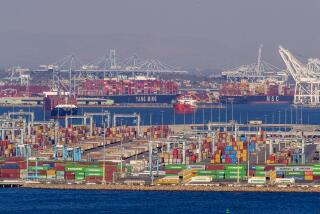Long Beach’s Loss Could Be S.D.’s Gain
- Share via
While San Diegans are fighting to keep the Naval Training Center and the Marine Corps Recruit Depot open, some local shipyard executives are hoping that the Long Beach Naval Shipyard remains on the federal hit list.
The Base Closure and Realignment Commission, which will issue a final report to Congress in July, has recommended that the NTC be closed and the MCRD be downsized. It also stunned officials in Long Beach by recommending that the 48-year-old Navy repair yard, which previously had been taken off the hit list, be returned to the list of bases recommended for closure.
The Long Beach facility, with 4,300 civilian employees, is the Navy’s main repair yard on the West Coast, handling an estimated 75% of Navy repair work completed by West Coast yards. The Long Beach yard competes with private yards up and down the West Coast, including National Steel & Shipbuilding Co. and Southwest Marine in San Diego.
The nation’s private yards--including NASSCO and Southwest--have been scrambling for work in recent years because few new commercial ships are being built. Work on new military ships is also slowing, and yards are redoubling their efforts to win military repair work.
A decision to close the Long Beach yard would “significantly increase the potential for . . . work at private yards,” said NASSCO spokesman Fred Hallett. “And there is significant idle capacity at those private yards.”
The Long Beach yard prides itself on being an economically competitive yard. The secretary of the Navy recently commended the yard for saving the Pentagon more than $80 million during the past four years by completing work under cost.
But executives at privately owned yards argue that their facilities are more cost-effective than Long Beach’s. “Private yard labor costs are lower, that’s a known fact,” Hallett said. “We know that our productivity is higher than at the Long Beach Navy Yard.”
Private yards will urge Congress, the final arbiter on which military bases will be closed, to give strong consideration to costs, Hallett said. But cost shouldn’t be the determining factor, he said.
“The decision should be made in light of the Navy’s strategic long-term plan,” Hallett said. “There are determinations other than cost . . . (including) their capability of repairing ships in time of conflict.”
More to Read
Sign up for Essential California
The most important California stories and recommendations in your inbox every morning.
You may occasionally receive promotional content from the Los Angeles Times.










